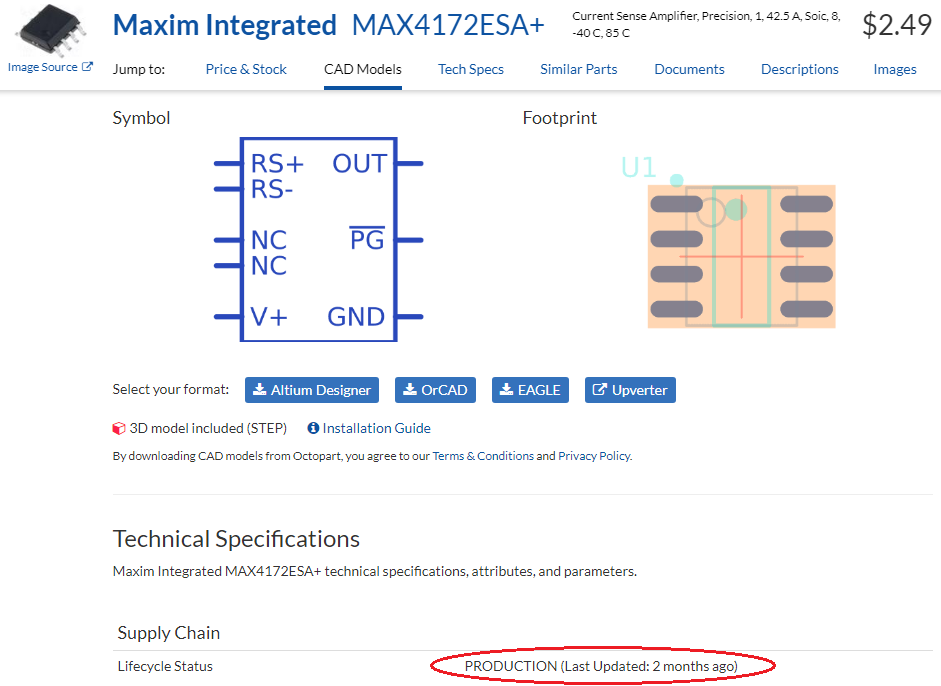
Every electronic component has a finite lifecycle and is destined to go obsolete eventually. Some components have drop-in replacements, or they may be updated and copied by manufacturers, and the lifecycle for a product can continue into the future without needing to find a complete replacement. Other components are so ubiquitous that we almost take it as gospel that they never go obsolete, only to find obsolescence occurs when we least expect it.
If you don’t want to deal with the headache of sourcing replacements, and you want to ensure the longest possible life for your new product, then you need to see component lifecycle information. So when is the time to search for component lifecycle data, and where can it be quickly located without spending hours on the web? With the right parts data aggregator, designers can get access to the component lifecycle data while searching for components on the front end, rather than going through an unnecessary redesign on the back end.
What Component Lifecycle Statuses Mean
If you’re a new designer and you’ve never jumped into the electronics supply, here’s your chance to learn some of the basic points. Aside from availability and lead times, perhaps the most important factor that will determine whether to include a component in a new product is its lifecycle stage.
If you can spot a soon-to-be obsolete component early, you can find an alternative before your design nears completion. The sooner you determine a component has or will soon be obsolete, you reduce your risk of redesigns and extend your product’s relevant lifetime. Similarly, if you can avoid components that will soon go obsolete, you can extend the useful lifetime of your product.
Component Lifecycle Stages
The different stages of a component lifecycle can be defined in terms of demand and in terms of a manufacturer’s product offerings. The two are obviously related; manufacturers will keep components in production if they remain in high demand, but they will also put newer components into production when they provide new features or upgraded capabilities.
If you look at distributor websites, they might list different components as “Active” or “Inactive,” which are ambiguous lifecycle statuses; they don’t always tell you what stage of the lifecycle a component is in. Manufacturers and some distributors tend to do a better job of listing lifecycle stages, and a good parts search engine will give you a more specific view of a component’s lifecycle stage.
Manufacturers use the following designations for each stage of a component’s lifecycle:
If you’re looking at a distributor’s website, keep in mind that a component listed as in-stock or “Active” does not mean it would be recommended for use in new designs. An inactive component is generally obsolete, or it could refer to NRND, although there can be remaining stock with distributors and secondhand suppliers for many years.
Why Components Go Obsolete
All components will eventually go obsolete for a number of reasons. One common reason is reduced demand for an existing component combined with a new component in production. This then forces the manufacturer to come up with a competitive replacement or to designate the older component NRND/EOL and abandon the product altogether. Some products with shorter lifecycles (e.g., smartphones) will have critical components with shorter lifecycles (e.g., memories). Historically, the semiconductor industry issues more EOL notices when the target market is not doing well; they simply take more components out of production to save on costs.
A component might remain NRND for several years before active production ends and the manufacturer lists the last time to buy or EOL notice. Once a component goes EOL and is marked obsolete, it may still be available from various distributors, even though replacements might be available. For one-off designs or prototypes, this might not be a problem as you don’t expect that specific design to go through repeated production runs anyways. If you can get component lifecycle information early, you can ensure your product and its components can have the longest possible lifetime. In the event you need to do an upgrade, you can also reduce the extent of future redesigns.
Get Your Component Lifecycle Information Early
If you use a search engine with advanced filtration features, you can sift through a huge amount of information, including component lifecycle. The best electronics search engine will compile sourcing information, prices, specifications, and alternative components into a single platform. Even better is when your search engine gives you access to CAD models for your components. This is a much better option than browsing distributor websites, and it gives you real-time supply chain information in times of supply chain volatility.

When you’re looking for component lifecycle information during sourcing, you need an electronics parts search engine that compiles lifecycle data, sources, stocks, lead times, prices, and lifecycle data into a single platform. Octopart gives you this information alongside CAD models in a single platform. Octopart also offers a Part Selector guide to help you find the best components for new products.
Stay up-to-date with our latest articles by signing up for our newsletter.